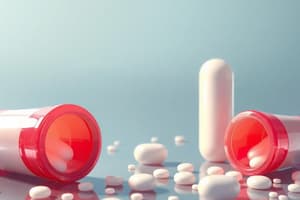Podcast
Questions and Answers
What is a characteristic of an ideal suppository base?
What is a characteristic of an ideal suppository base?
- It should be stable on storage. (correct)
- It should be highly irritating.
- It must dissolve quickly in oil.
- It should react strongly with medications.
How does the melting point of a suppository base affect drug release?
How does the melting point of a suppository base affect drug release?
- Melting point has no effect on drug action.
- A melting point at body temperature promotes drug release. (correct)
- A higher melting point increases absorption.
- A lower melting point slows down drug action.
What can happen if a base interacts negatively with the drug?
What can happen if a base interacts negatively with the drug?
- Drug stability will improve.
- The drug will be absorbed effectively.
- Drug absorption can be impaired or prevented. (correct)
- The base will always enhance the drug effect.
Which component is NOT a characteristic of fatty bases used in suppositories?
Which component is NOT a characteristic of fatty bases used in suppositories?
What effect does an irritating base have on the digestive system?
What effect does an irritating base have on the digestive system?
Which type of base is Cocoa butter categorized as?
Which type of base is Cocoa butter categorized as?
Why is it important for a suppository base to be easily molded?
Why is it important for a suppository base to be easily molded?
What is a potential drawback of using a poorly designed suppository base?
What is a potential drawback of using a poorly designed suppository base?
Which of the following is a characteristic of hydrophilic bases?
Which of the following is a characteristic of hydrophilic bases?
What is a disadvantage of glycerogelatin bases?
What is a disadvantage of glycerogelatin bases?
Which of the following is an example of a water-soluble base?
Which of the following is an example of a water-soluble base?
What is the primary component of the glycerol suppository base according to the BP standard?
What is the primary component of the glycerol suppository base according to the BP standard?
What can happen due to the hygroscopic nature of glycerogelatin?
What can happen due to the hygroscopic nature of glycerogelatin?
What is one important characteristic of an ideal glycerogelatin suppository?
What is one important characteristic of an ideal glycerogelatin suppository?
What is a risk associated with glycerogelatin suppositories?
What is a risk associated with glycerogelatin suppositories?
Why should glycerogelatin bases be stored in tight containers?
Why should glycerogelatin bases be stored in tight containers?
What is the approximate quantity of fluid available for drug dissolution in the rectum?
What is the approximate quantity of fluid available for drug dissolution in the rectum?
What is the ideal characteristic of drugs used rectally regarding their solubility?
What is the ideal characteristic of drugs used rectally regarding their solubility?
What effect does particle size have on drug absorption in rectal administration?
What effect does particle size have on drug absorption in rectal administration?
How does the state of the rectum (full or empty) impact drug absorption?
How does the state of the rectum (full or empty) impact drug absorption?
What is the role of the partition coefficient in drug absorption?
What is the role of the partition coefficient in drug absorption?
What is a characteristic of rectal fluids concerning pH?
What is a characteristic of rectal fluids concerning pH?
What happens to drug absorption when using slightly soluble drugs in the rectum?
What happens to drug absorption when using slightly soluble drugs in the rectum?
What effect does a full rectum have on drug absorption?
What effect does a full rectum have on drug absorption?
What happens to cacao butter suppositories when the percentage of solid exceeds 30%?
What happens to cacao butter suppositories when the percentage of solid exceeds 30%?
What is a recommended additive to reduce brittleness in cacao butter suppositories?
What is a recommended additive to reduce brittleness in cacao butter suppositories?
What is the acceptable deviation for the weight of any suppository from the average weight?
What is the acceptable deviation for the weight of any suppository from the average weight?
What should the drug content in each suppository not deviate from?
What should the drug content in each suppository not deviate from?
What temperature should the water bath be for the liquefaction time test?
What temperature should the water bath be for the liquefaction time test?
What is the purpose of the breaking test for suppositories?
What is the purpose of the breaking test for suppositories?
Which of the following characteristics should NOT be present in the appearance of suppositories?
Which of the following characteristics should NOT be present in the appearance of suppositories?
How many suppositories should be assayed for drug content uniformity?
How many suppositories should be assayed for drug content uniformity?
What is the main reason cocoa butter must be slowly melted over a warm water bath?
What is the main reason cocoa butter must be slowly melted over a warm water bath?
What happens if cocoa butter is quickly heated and then cooled suddenly?
What happens if cocoa butter is quickly heated and then cooled suddenly?
What is a disadvantage of cocoa butter regarding its adherence to molds?
What is a disadvantage of cocoa butter regarding its adherence to molds?
What is the suitable melting point range of cocoa butter for it to remain solid?
What is the suitable melting point range of cocoa butter for it to remain solid?
How do some drugs like phenol and chloral hydrate affect cocoa butter's melting point?
How do some drugs like phenol and chloral hydrate affect cocoa butter's melting point?
What agent can be added to cocoa butter to raise its melting point when certain drugs are present?
What agent can be added to cocoa butter to raise its melting point when certain drugs are present?
What is a potential issue with cocoa butter during storage?
What is a potential issue with cocoa butter during storage?
What method can help in reducing the sticking of cocoa butter suppositories to the mold?
What method can help in reducing the sticking of cocoa butter suppositories to the mold?
What is a primary advantage of using soap glycerin for suppositories?
What is a primary advantage of using soap glycerin for suppositories?
Which of the following is a disadvantage of soap glycerin in suppository formulation?
Which of the following is a disadvantage of soap glycerin in suppository formulation?
Why should water be avoided in suppository preparations?
Why should water be avoided in suppository preparations?
What factor affects the hygroscopicity of PEG bases?
What factor affects the hygroscopicity of PEG bases?
What issue can lead to brittleness in suppositories?
What issue can lead to brittleness in suppositories?
What can be added to increase the viscosity of suppositories if it is too low?
What can be added to increase the viscosity of suppositories if it is too low?
What is a drawback of glycerogelatin suppositories in relation to humidity?
What is a drawback of glycerogelatin suppositories in relation to humidity?
Which statement is true regarding the use of fat in suppository formulations?
Which statement is true regarding the use of fat in suppository formulations?
Flashcards
Rectal Fluid Quantity
Rectal Fluid Quantity
The amount of fluid in the rectum is very small, approximately 3 ml. This limits how much drug can dissolve and be absorbed.
Rectal Drug Solubility
Rectal Drug Solubility
Drugs used rectally need to dissolve quickly in the rectal fluid for efficient absorption. They should have high aqueous solubility.
Rectal Fluid pH
Rectal Fluid pH
The pH of rectal fluid is neutral (around 6.5-8) and doesn't have much buffering capacity. This means that drugs need to be stable in this pH range.
Empty Rectum - Absorption
Empty Rectum - Absorption
Signup and view all the flashcards
Full Rectum - Absorption
Full Rectum - Absorption
Signup and view all the flashcards
Partition Coefficient
Partition Coefficient
Signup and view all the flashcards
Particle Size
Particle Size
Signup and view all the flashcards
Base Properties
Base Properties
Signup and view all the flashcards
Base Dissolution
Base Dissolution
Signup and view all the flashcards
Base-Drug Interaction
Base-Drug Interaction
Signup and view all the flashcards
Irritating Base
Irritating Base
Signup and view all the flashcards
Non-Toxic and Non-Irritant
Non-Toxic and Non-Irritant
Signup and view all the flashcards
Base Inertness
Base Inertness
Signup and view all the flashcards
Melting or Dissolving Base
Melting or Dissolving Base
Signup and view all the flashcards
Drug Release from Base
Drug Release from Base
Signup and view all the flashcards
Base Stability
Base Stability
Signup and view all the flashcards
Polymorphism of Cocoa Butter
Polymorphism of Cocoa Butter
Signup and view all the flashcards
Adherence to the Mold
Adherence to the Mold
Signup and view all the flashcards
Softening Point of Cocoa Butter
Softening Point of Cocoa Butter
Signup and view all the flashcards
Lowering Melting Point by Drugs
Lowering Melting Point by Drugs
Signup and view all the flashcards
Raising Melting Point by Drugs
Raising Melting Point by Drugs
Signup and view all the flashcards
Compensating Melting Point Changes
Compensating Melting Point Changes
Signup and view all the flashcards
Rancidity of Cocoa Butter
Rancidity of Cocoa Butter
Signup and view all the flashcards
Miscibility of Cocoa Butter
Miscibility of Cocoa Butter
Signup and view all the flashcards
Hydrophilic Suppository Bases
Hydrophilic Suppository Bases
Signup and view all the flashcards
Glycerogelatin Base
Glycerogelatin Base
Signup and view all the flashcards
PEG (Macrogol) Base
PEG (Macrogol) Base
Signup and view all the flashcards
Soap Glycerin Base
Soap Glycerin Base
Signup and view all the flashcards
Laxative Effect of Glycerogelatin Bases
Laxative Effect of Glycerogelatin Bases
Signup and view all the flashcards
Rectal Irritation of Glycerogelatin Bases
Rectal Irritation of Glycerogelatin Bases
Signup and view all the flashcards
Unpredictable Dissolution Time of Glycerogelatin
Unpredictable Dissolution Time of Glycerogelatin
Signup and view all the flashcards
Microbial Contamination Risk of Glycerogelatin
Microbial Contamination Risk of Glycerogelatin
Signup and view all the flashcards
Glycerogelatin suppositories
Glycerogelatin suppositories
Signup and view all the flashcards
Soap Glycerin suppositories
Soap Glycerin suppositories
Signup and view all the flashcards
Hygroscopicity
Hygroscopicity
Signup and view all the flashcards
Water in suppositories
Water in suppositories
Signup and view all the flashcards
Viscosity in suppositories
Viscosity in suppositories
Signup and view all the flashcards
Brittleness in suppositories
Brittleness in suppositories
Signup and view all the flashcards
PEG (Macrogol) base suppositories
PEG (Macrogol) base suppositories
Signup and view all the flashcards
Hydrophilic
Hydrophilic
Signup and view all the flashcards
Cacao Butter Brittle?
Cacao Butter Brittle?
Signup and view all the flashcards
Fixing Cacao Butter Brittleness
Fixing Cacao Butter Brittleness
Signup and view all the flashcards
Weight Uniformity Test
Weight Uniformity Test
Signup and view all the flashcards
Weight Uniformity Limits
Weight Uniformity Limits
Signup and view all the flashcards
Drug Content Uniformity Test
Drug Content Uniformity Test
Signup and view all the flashcards
Liquefaction Time Test
Liquefaction Time Test
Signup and view all the flashcards
Breaking Test (Hardness)
Breaking Test (Hardness)
Signup and view all the flashcards
Stability Test
Stability Test
Signup and view all the flashcards
Study Notes
Suppositories and Pessaries
- Suppositories are medicated, molded solid dosage forms of various sizes and shapes designed for insertion into body cavities (rectum, vagina, or urethra).
- Suppositories are inserted into the rectum.
- Pessaries are inserted into the vagina.
Types of Suppositories
- Rectal suppositories: conical or torpedo shape, ~2-3 cm length.
- Adult dose: ~2 gm
- Child dose: ~1 gm
- Urethral suppositories (Bougies): cylindrical or tube shape in globular or oval form, ~3-6 mm diameter.
- Adult dose: ~4 gm
- Child dose: No data given
- Vaginal suppositories (pessaries): cylindrical or tube shape in globular (ball), oval or cone-shaped, ~4-5 gm in weight.
Action of Suppositories
- When inserted into the body, suppositories and pessaries either melt, soften, or dissolve, and exert a local or systemic effect.
Advantages of Suppositories
- Local effect:
- Treat infections, pain and inflammation (e.g., hemorrhoids, vaginal fungal infections).
- Relieve constipation.
- Treat diseases of the colon (e.g., ulcerative colitis).
- Systemic effect:
- For babies or elderly unable to swallow oral medication.
- Post-operative patients.
- People with nausea or vomiting.
- Drugs irritating to the stomach.
- Drugs destroyed by the pH or enzymatic activity of the stomach or intestine
- Drugs destroyed by portal circulation (bypass first-pass metabolism)
Disadvantages of Suppositories
- Inconvenient: Not favored by patients, especially children; some suppositories leak or are expelled.
- Rectal absorption: Slow, irregular, and unpredictable.
- Mucosal irritation: Caused by some drugs or bases.
- Manufacturing/Storage costs: Higher than other drug forms.
Physiology of the Rectum
- The rectum is ~15-20 cm in length, with 1.5-3 ml of fluids.
- The pH is ~6.8.
Absorption of Drugs from the Rectum
- 50-70% of drugs absorbed directly into the bloodstream via hemorrhoidal veins, bypassing the liver's first-pass metabolism.
- Route of absorption differs based on inferior vs. superior hemorrhoidal veins.
Factors Affecting Rectal Absorption
- Physiological factors:
- Site of insertion.
- Route of absorption and circulation.
- Quantity of rectal fluid.
- Properties of rectal fluid.
- Contents of the rectum.
- Physicochemical factors:
- Partition coefficient.
- Particle size.
- Nature of the base.
Properties of Rectal Fluids
- Neutral pH (6.5-8).
- No buffer capacity.
Contents of the Rectum (Empty vs. Full)
- Empty rectum: Rapid drug absorption, rapid onset of action.
- Full rectum: Slower drug absorption, delayed onset of action.
Physicochemical Factors Affecting Absorption
- Drug solubility: Drugs highly soluble in the base will have slow release into rectal fluids, resulting in slow absorption; conversely, high solubility in rectal fluids leads to faster and more rapid absorption.
- Particle size: Smaller particle size leads to faster dissolution and faster absorption.
- Base properties: The ability of the base to melt, soften or dissolve will determine release rate of the drug leading to a faster or slower rate of drug action.
- Base interactions with the drug will impair or even prevent drug absorption.
- Bases which irritate mucous membranes will initiate a colonic response and bowel movement; incomplete drug release and absorption.
Ideal Suppository Bases
- Non-toxic and non-irritant.
- Inert and compatible with the drug.
- Melts or softens at body temperature or dissolves in body fluids.
- Readily releases the drug.
- Easily molded and removed from the mold.
- Stable to heating above the melting point.
- Stable on storage.
- Easy to handle.
Types of Suppository Bases
- Fatty (Oleaginous/Hydrophobic): Cocoa butter, semi-synthetic fats. Melt at body temperature.
- Hydrophilic (Water-Miscible/Water-Soluble): Glycerogelatin, PEG (Polyethylene Glycol), sorbitol, soap glycerin. Dissolve rather than melt at body temperature.
Cocoa Butter (A-Type)
- Benefits: Solid at room temperature but melts at body temperature, miscible with many ingredients, non-irritating, non-toxic.
- Drawbacks: Polymorphism (different crystalline forms depending on cooling rate).
- Additional notes: Adherence to the mold; softening point may be too low for hot climates, requiring refrigeration during storage, melting point may be lowered by some drugs, or raised by others, rancidity on storage.
Cocoa Butter Substitutes (B-Type)
- Benefits: Unaffected by overheating, low level of unsaturated fatty acids, good resistance to oxidation (preventing rancidity).
- Drawbacks: More expensive, Brittle, can be challenging to handle, wrap, and use; greater risk of drug particles sedimenting during preparation, potentially causing localized irritation, requiring refrigeration for preparation and handling.
Hydrophilic Bases
- Benefits: No laxative effect, less microbial contamination, melting points are typically above body temperature.
- Drawbacks: Very hygroscopic (absorb water), requiring special packaging and storage, potentially lowers drug bioavailability by binding drugs in the base, potentially incompatible with certain drug types and/or packaging materials.
Problems in Formulation and Storage
- Water: Should be avoided in suppositories, as it can increase the oxidation of fats and create bacterial/fungal growth, increase degradation rate of drugs, and cause reactions. If water evaporates, the drugs might recrystalize.
- Hygroscopicity: Glycerin and PEG are hygroscopic.
- Viscosity: Low viscosity may require additives for uniform dispersion of the drug.
- Brittleness: Some substances can be brittle if cooled rapidly; additional components can prevent brittleness.
Suppository Evaluation and Quality Control
- Appearance: Uniformity in size, shape, and color; no cracks or pits.
- Weight uniformity: Compare individual weights to the average weight; no significant differences.
- Drug content uniformity: Assesses the drug content in each suppository, comparing the results with the labelled drug content.
- Liquefaction Time: Measures the time it takes for the suppository to fully melt or disperse in a constant temperature water bath.
- Breaking Test: Measures the suppository's hardness and resistance to breaking.
- Dissolution test: Measures the rate at which the drug dissolves.
- Stability test: Assesses the long-term storage stability of the suppositories.
Studying That Suits You
Use AI to generate personalized quizzes and flashcards to suit your learning preferences.




